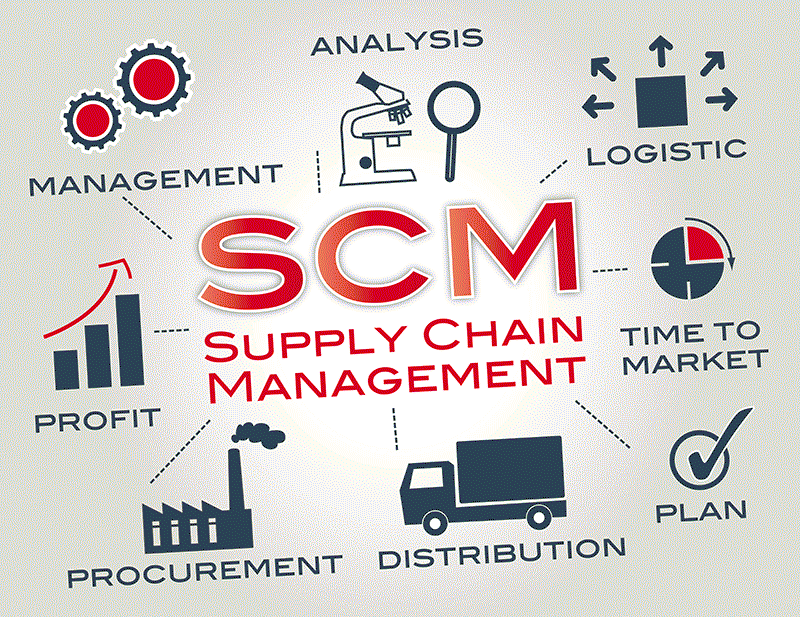
This calculator helps you determine how much inventory you should hold, and when you should place inventory orders. The calculation attempts to keep your inventory level as efficient as possible, while maintaining adequate safety stock.
Businesses provide services and manufacture goods that make people's lives easier. Uber links people with car rides with a few simple clicks on smartphones. Walmart helps families around the United States afford groceries, home necessities, and clothes at bare-minimum prices. Convenience stores provide gasoline for vehicles to traverse around.
One thing these businesses, like most others, have in common is their reliance on inventory.
There are around 28 million businesses in the United States. A large majority of them use inventory in some capacity. Orthodontists need inventory to fix patients' braces. Dentists send virtually every patient home with a toothbrush, toothpaste, mouthwash, and floss. Teachers need pencils and paper to educate students. Caterers need plates, silverware, and glasses to feed their customers. Accounting firms need office supplies to meet clients' needs. These five types of businesses are strictly service providers, rather than retail stores whose "bread and butter" are products, that still rely on inventory.
Proper inventory management is necessary for success in business. Stocking too much inventory can result in stock becoming obsolete, effectively wasting money. Not having enough inventory yields customer dissatisfaction and temporary loss of revenue. If customers experience multiple inventory shortages, they may value that business less, stop visiting as frequently, and even spread negative reviews about it.
Following is a guide detailing the basics of inventory management and strategies to effectively, efficiently maintain stock levels.

Businesses that retail and distribute inventory need to keep close tabs on current stock levels to prevent excess inventory from becoming obsolete, and from making customers dissatisfied for not having products in stock. Organizations that use inventory in-house, but only provide services, need inventory to maintain regular business operations.
Inventory management involves maintaining sufficient levels of products and supplies for in-house and reselling uses. The study deals with storing inventory and making it easy for employees to locate various products. Stock maintenance also concerns readily locating supplies, materials, and goods for use in manufacturing, retailing, and other business-related capacities. Today, computer systems assist in functions related to inventory, which are much more efficient with computers than taking note of stock manually with pencil and paper.
Because businesses engage in countless activities, ways of improving business functions depend on particular situations. However, here are several ways of carrying out better inventory management.
Shop around
The most reputable providers of products and materials might not always be the largest and most reputable. Look around magazines, the Internet, and advice solicited from other businesses to find the best deals on inventory. Also, don't be afraid to trust newer distributors and manufacturers with less feedback than well-established organizations. New companies are commonly desperate for getting more customers and will provide customers with attractive, valuable deals for doing business with them.
Use the same vendors time after time
Once a business has located a trusted vendor with good deals, they should try their best to stick with that supplier at all costs. Businesses appreciate when their customers trust them over long periods of time, providing consistency in their operations. As such, suppliers that have long-standing relationships with their customers may offer better deals than other suppliers or be more likely to conform to unique, irregular demands.
Make payments ahead of time
Businesses often sell goods on credit to other businesses, unlike most business-to-end-user transactions. As such, they detail terms of payment usually receivable in 30 to 60 days, offering discounts for paying balances before they're due. Not only can a business save money by paying before balances are due, they may be able to earn large credit approvals unlike other customers due to their long-running loyalty and reliability.
Only offer goods on credit to trusted customers, if any
Extending goods on credit to all customers may result in not making good on amounts spent to obtain products, pay employees, and otherwise facilitate the sales process. Only offer goods on account to trusted associates that have proven to pay balances on time and in full. It might be a good idea to not extend credit to any customer, regardless of how long they've been associated with your business.
Don't purchase too much inventory
As technology rapidly advances, many products go out of style, becoming unwanted or unusable. While spending money towards maintaining sufficient levels of inventory may prevent customers from experiencing product shortages, housing goods for extensive periods of time takes away from storage area for other products and wastes money.
Increase COGS turnover at all costs
COGS is a business term that stands for cost of goods sold, and includes all expenses incurred for selling products. The largest COGS expense is almost always inventory. COGS turnover refers to how many times a business' inventory is sold throughout a year's time. The faster inventory turnover occurs, the more possible it is to earn higher profits. Some products sell at different speeds than others, so it's important to make note of average speeds it takes for particular products to fly off shelves. Invest in inventory that is purchased frequently, as that will increase cash flow reducing the length of time a company's working capital is tied up in illiquid inventory.
Look for suppliers that extend goods on credit
Although it's common business practice to extend goods on credit, some suppliers have unfavorable terms with short payback periods, high interest rates, or an absence of early payment discounts. Some vendors might not sell goods for anything other than cash paid upfront at the time of delivery. If at all possible, stay away from suppliers whose terms aren't favorable.
Keep high inventory turnover
Inventory that remains on shelves for lengthy periods of time don't speedily earn money for their buyers. While high-dollar items usually take longer to sell than their cheaper counterparts, maintaining rapid inventory turnover is an effective way of financing inventory growth.
Borrow more inventory against existing inventory or other assets
Having inventory loaned to a company isn't always a good idea, but may be necessary for capitalizing on potential growth. Each supplier has different terms, but existing inventory, equipment, facilities, and virtually every other asset can be used to secure financing for inventory.
Make processes relate to inventory hard to misinterpret
Business owners may understand complex inventory maintenance procedures, but employees may not. Furthermore, employees don't have the same stake in businesses as owners do, resulting in many employees not caring about doing things correctly as much as high-ranking managers and owners. Keeping processes related to unloading shipments, recording inventory levels, and shipping them out simple are likely to result in more accurate inventory counts.
Utilize RFID tags
Radio frequency identification is a relatively new technology that helps businesses keep track of employees, equipment, and inventory. RFID tags cost as little as ten cents per tag. Businesses must also have equipment to read inventory with RFID tags, which are definitely more expensive than ten cents. Employees can be equipped with handheld devices or warehouses can be equipped with static equipment that records inventory as it enters the facility or is placed in storage areas. As long as all inventory is equipped with RFID tags, maintaining accurate inventory counts is far easier than hoping to do so manually.
Only invest in inventory management systems that are easy to understand. Make sure all employees, even entry-level employees with little technological familiarity, can understand how to use them properly. If a business has tens of thousands of materials or products in its warehouse, using simple computer programs may not be possible. However, most businesses don't have this much inventory, so finding an inventory management system that isn't difficult to understand should be relatively easy.

The proliferation and rapid advancement of technology has led to easy access to effective, easy-to-navigate inventory management programs. They help order inventory when stock is low, forecast sales, and maintain accurate inventory counts. Here are some of the most popular computer programs to keep track of inventory.
Oracle is credited for NetSuite's development nearly twenty years ago. Businesses that utilize this program for maintaining stock levels find that Oracle provides superior customer support for organizations that may struggle to implement and maintain it. NetSuite uses a cloud to store information, making it accessible from every computer or smartphone, regardless if it has the program installed on it. However, NetSuite is generally reserved for large businesses or those with large endowments, with low-end pricing beginning at $10,000 annually. Fortunately, it does feature unlimited growth potential.
This program is geared towards all types of businesses, with various packages developed specifically for manufacturers, retailers, warehouses, and several other trades. Fishbowl can be utilized by organizations using Windows or Mac operating systems. It's ideal for warehouses near the coast of countries they operate in, as it is compatible with more than one currency. Arguably the only setback of Fishbowl is an inability to to import inventory data from other programs, although not every business will find it necessary to do so.
Tradegecko is geared specifically towards warehouses that don't engage in retail sales. Its interface is easy to become familiar with, even beginners with limited computer experience. As such, Tradegecko facilitates accurate inventory tracking by all employees, from owners to new hires. Stock information recorded on Excel or other spreadsheets are easily imported, eliminating data entry jobs during the middle of facility transfers or adopting new computer programs. Unfortunately, just-in-time inventory management is made difficult because Tradegecko doesn't inform users of when inventory supplies are running low. However, this program features a friendly mobile interface that employees can utilize from their self-owned smartphones.
Nearly every business in the United States uses inventory in some form or fashion, with a majority of them relying extensively on proper inventory levels. A failure to maintain sufficient stock may result in customers becoming dissatisfied and choosing other businesses to meet their needs. Likewise, having a surplus of products on hand could lead to inventory becoming obsolete and subsequent reductions in profit.
Virtually every business needs help with inventory management, even the largest, most well-established of organizations. Using these tips, business owners can increase accuracy in which they record stock levels, less frequently run out of inventory, increase customer satisfaction, and ultimately increase business performance.
Explore conventional mortgages, FHA loans, USDA loans, and VA loans to find out which option is right for you.
Check your options with a trusted Columbus lender.
Answer a few questions below and connect with a lender who can help you save today!